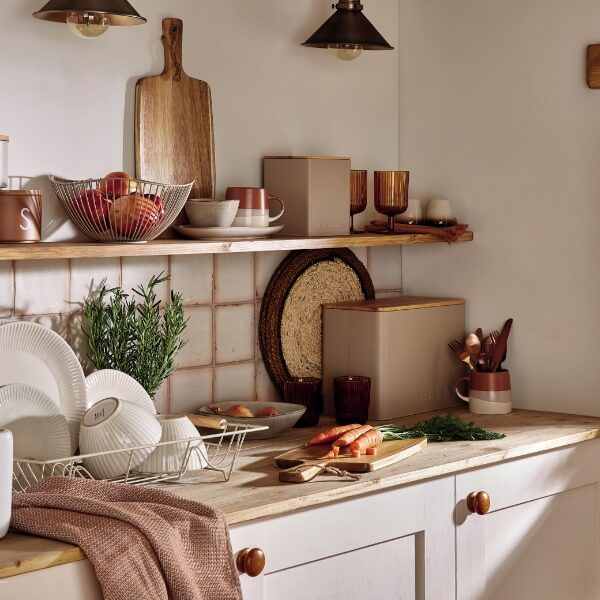How To Organise Your Kitchen
We’ve all seen the Pinterest images of immaculate and organised kitchen cupboards and drawers with minimal glass jars stocked full of cooking ingredients and plastic boxes which are lined up with cleaning products, but how easy is it to create those kinds of kitchen storage solutions at home? Very, if you follow a few of our simple and easy-to-follow tips and ideas. It shouldn’t take long but will undoubtedly transform the way you use your kitchen, even if you’re short on space.
On this page you’ll find everything you need to organise your kitchen yourself. All it will take is a bit of forward planning, some cleaning products and a few hours dedicated to sorting, clearing and putting things back in a wonderfully streamlined way.
To make things easier we’ve included a few of our favourite easy kitchen storage ideas that are both affordable and simple to implement, as well as sharing some brilliant products that will aid your quest for organisational bliss. Together, they’ll instantly transform your cupboards, drawers, pantry and fridge and make them much more practical for everyday use. They’ll also make your kitchen look pretty too, and hey, that’s never a bad thing, right?
We’ll also talk you through how to better store the food items you likely already have in your kitchen. Things like pasta, grains and rice which could be more efficiently stored in alternative ways, as well as household items like cleaning products and utensils. We’ve also got some great ideas about how you can maximise open surfaces and walls which will be especially useful if you’re looking for small kitchen storage ideas.
So, without further ado, keep on reading for our ideas on how to organise your kitchen…
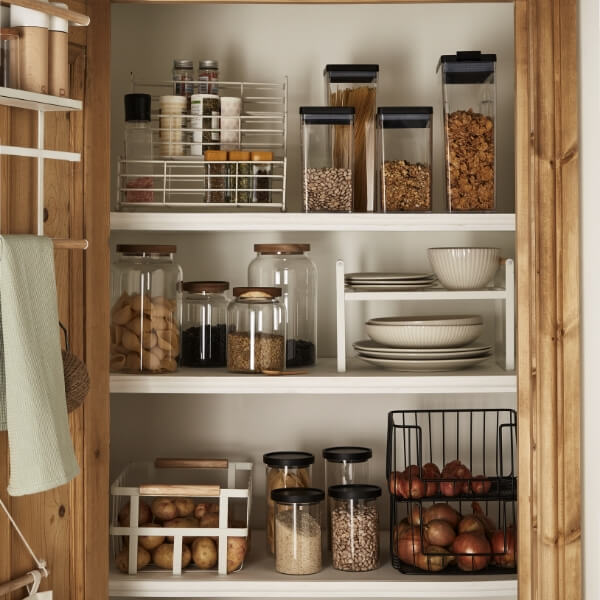
How To Organise Kitchen Cupboards
The first place to tackle when considering how to organise your kitchen is the cupboards. Sorting your kitchen cupboards is an easy job that just requires some patience and a little bit of prep and planning. Take some time to think about how you use your kitchen and which items you find yourself reaching for more often, and which items can be kept on a higher shelf or stored elsewhere.
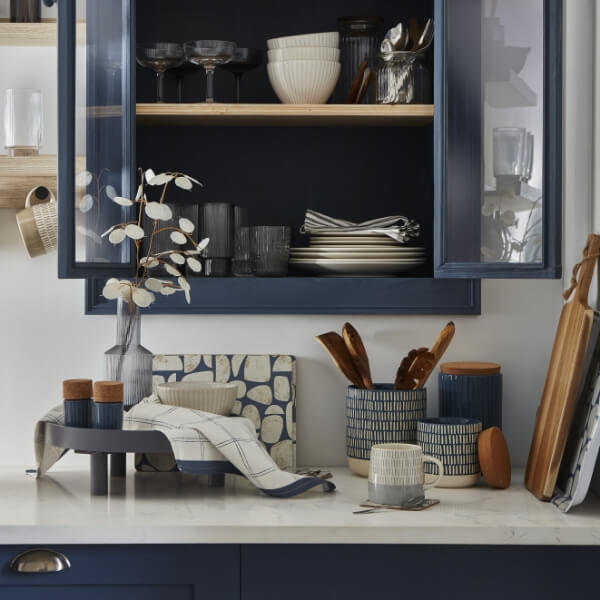
Tips for Organising Your Kitchen Cupboards
Have A Clear Out
First off, it’s important to assess whether you need or want the things taking up space in your kitchen cupboards. Take time to throw away items you no longer use and to get rid of products that are past their sell-by date.
Do A Deep Clean
Grab the cleaning products and give everywhere a thorough wipe through, taking time to remove any crumbs or leftover residues. Starting with a fresh, clean space in your cupboards will help keep you nice and motivated to keep it organised once all your hard work in organising them is complete.
Think About What You Might Need To Buy
Baskets, trays and jars are you best friends when it comes to a complete organisational overhaul of your kitchen cupboards. Not only do they look much neater and create a more streamlined use of your storage space, but they also make it much easier to find things. Invest in an array of styles to help store different items.
Using clear containers will also help you see what you have which means you’ll save time when grabbing things from the cupboard, but also will make things like writing your food shopping list much easier! Keeping something like spaghetti in a tall upright canister will save much more space compared to having it lying down flat in a cupboard. You may find that some of your containers are better kept on your worktops or open shelves.
Start by measuring your shelves and working out how many storage items like baskets and jars will fit into your space – doing this first means you can maximise how much you can fit into a small kitchen space. Two baskets or trays would look great next to each other, whilst you may be able to neatly arrange a collection of glass jars next to each other on another shelf. Feel free to go ahead and mix and match styles to create a look that’s unique to you when organising your kitchen cupboards.
Start The Organising!
Start with your food cupboard. Empty anything that’s in packets (things like pasta, rice, grains, cereals, flour, baking ingredients – anything that’s dry) into your jars or canisters. You could also label these with a label maker or with chalkboard stickers to make foods easier to identify. Ensure you place the things you reach for most regularly at the front and at eye level to avoid having to move things around each day.
Next, work through other kitchen items that could be grouped together. Maybe you could place all tinned goods in a box or basket, or empty loose multipack items such as crisps or cereal bars into another box or basket. You want everything in your kitchen to have a home and a place that it lives, rather than have loose items that are prone to spilling and creating mess.
When it comes to kitchen utensils and pots and pans in a kitchen cupboard, stacking is key. Alternatively, to save cupboard space altogether you could also consider hanging them to free up more room for other items. Make sure you get rid of anything you don’t use (or place in an area of your kitchen or home that you don’t need such easy access to) and focus on placing the things you do use every single day within easy reach, at the front of your cupboards. Tupperware should have a designated storage space and things like oven dishes and trays should be stacked from largest to smallest.
With plates, bowls and mugs it’s always easiest to stack where you can. You could also buy a plate stand to help separate different sizes whilst still making them easy to get to. Another option for mugs is a mug tree on your kitchen work top if you have room to spare, or even on little hooks which could be attached to the underneath of your upper kitchen cupboards. Ensure mugs are kept close to the kettle and that plates are near the oven and hob for speedy serving!
The other item you might want to organise in your kitchen cupboards is glassware. Some people decide to store these in a dining room cabinet or on a drinks trolley, but if you’re short on room and keeping them in a kitchen cupboard then think about which one might work best. Do you access them regularly? Or do you have special glassware that’s just saved for occasions? You might want to separate the ones you use for everyday drinks and the ones that come out less frequently and keep them at different ends of the kitchen. It’s handy to have water glasses near the tap, whilst wine or cocktail glasses could be kept in a less accessible place.
And finally, the cleaning product kitchen cupboard. Again, the best way to organise this is with baskets and boxes which can be separated into categories and then labelled for your convenience. You might have a designated basket for anti-bacterial products, and another to keep clean cloths and sponges. Another idea would be to have one for stain removal products and perhaps one for your bathroom cleaning products which can then be taken to the bathroom when it’s time for a clean. You could also separate products like washing machine capsules or dishwasher jars into clear jars or canisters (so long as they’re out of reach of little hands), to make it easier to access them and keep track of when you need to buy more.
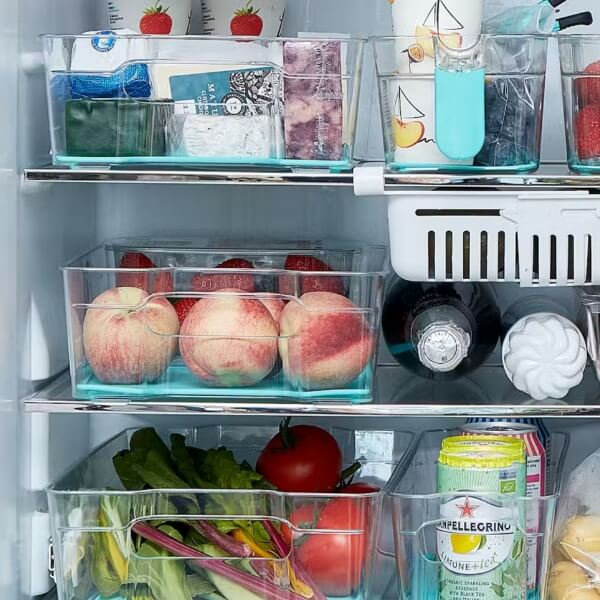
How To Organise Your Fridge
The kitchen storage solutions don’t have to stop at cupboards and drawers either, as there’s also plenty of ways to organise your fridge to keep it clean and make it easier to use. Our top tip? Invest in clear storage boxes and trays which will make it easier to separate food products.
Clean The Fridge
First things first, get your fridge looking brand new with a thorough deep clean. Take out existing drawers and shelves and give them a good scrub. Make sure to also throw away any products which are past their best.
Shop For What You Need
Work out how many plastic containers you might need for separating out different food groups. Maybe you’d like one for raw meat and another for cooked meat, and maybe you’d like one for dairy products. It might also be worth measuring how much space you have between shelves to find easily stackable Tupperware which would maximise space if you tend to refrigerate leftovers fairly often.
Get Organising Your Fridge
There are certain hygiene rules that it’s worth remembering when you put everything back inside your fridge. The top shelf and middle shelf are great places for foods that don’t need cooking. This can be all your dairy products as well as leftovers, cooked meats, drinks or fresh herbs if you have them. Your bottom shelf should always be reserved for raw meats (if you have them), whilst your fridge drawers are the best place to keep your fruits and vegetables. Your door is the ideal place to house condiments. Your fridge should be set to between three and five degrees to maximise the freshness of your foods.
Remember to stack where you can and to place the items that you might need to grab most regularly at the front, to avoid having to reach into the back of the fridge. It might also be worth labelling any trays, boxes or containers to help find things easily.
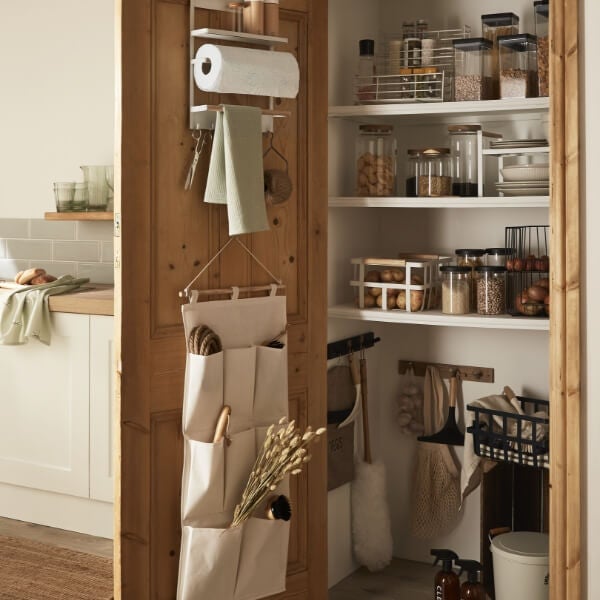
How To Organise Your Pantry
If you’re lucky enough to have a pantry this can be one of the most fun and efficient places to organise in your kitchen. By creating a real system you’ll not only make it much easier to use your kitchen and pantry, but you’ll also save space in other areas of the room.
Have A Clear Out
As with the other areas of your kitchen, start your organisation project by emptying out everything that’s in your existing pantry and throwing away or re-homing items that aren’t useful to you. Give the shelves a thorough wipe down and then get cracking!
Consider The Pantry Door
Consider whether you have space to hang anything on the inside of your pantry door. Aside from using the space for hooks for things like aprons or oven gloves, there might also be opportunity to hang something like a spice rack – or even an assortment of baking ingredients and decorations – which would be a brilliant small kitchen storage idea. If you love the look of open shelving and well-ordered jars and baskets, you may even want to remove the door to have better access to the items within.
Work Out What You Want To Store In Your Pantry
The joy of a pantry is that there’s lots of space to utilise and you can pick and choose exactly how you could best use that space. Maybe you keep all your food products in your pantry and save the cupboard space for pots and pans, or maybe you keep some of the food products – things like tins and jars – and then keep other items such as cleaning products, pet supplies, household items like loo roll and kitchen roll or even vases in there too.
Work Out What You Need To Buy
As with your kitchen cupboards, your pantry is a fantastic place to mix and match your storage solutions. You could opt for clear jars and canisters on one level, whilst woven baskets might work better on another. Measure your shelves before you order anything to make sure things will slot nicely next to each other.
Get Organising
Put everything back in a way which makes sense to you – both for how you want to use the space and for the items you want to store. Don’t forget to label jars or boxes to help you quickly identify where to look for things when in a hurry. Think about how to categorise each shelf to help organise your goods. You might have dried goods in jars on one shelf and then tins on another, and then loose veg in a basket on another. Keeping things separate and having categorised sections will help with the overall organisation moving forward and mean you might just be able to keep it neat and tidy…
